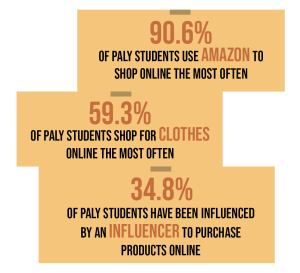Fast and furious: The pros and cons of social commerce
Art: Esther Xu
“I was like, ‘Damn, what the hell did I just do?’”
Palo Alto High School economics teacher Grant Blackburn described his reaction as he recalled his impulsive purchase of a pack of floor protection furniture pads through Facebook. He had been scrolling through social media with no intention of making any purchases, but once an advertisement for the product entered his feed, impulsivity took over and the purchase was made.
According to Accenture, a company specializing in technology services, social commerce is predicted to grow three times as fast as traditional e-commerce by 2025. As the use of social media platforms to advertise and sell products or services to customers grows, the social commerce market has become increasingly important for small businesses, but also presents risks of scams and impulsive purchases.
From small student-run businesses on TikTok and Instagram to major clothing brands such as Shein or H&M, social media has become increasingly important to business promotion and sales for many companies, according to Paly senior Lara Lew Strass. Strass says social commerce has helped her start her own jewelry business online.
“People can now buy items directly through TikTok, Pinterest and Instagram checkout, which has opened doors for small businesses to compete with large businesses,” Strass said. “Businesses no longer need physical locations; rather, they can be completely run and advertised from home, making the business space much more accessible for teens to start in.”
The social commerce market has been integrated into numerous social media platforms in the last few years, including Facebook, Instagram and TikTok. By 2021, the global social commerce market was estimated by Later, a social media management site, to be worth $89.4 billion USD and set to reach $604.5 billion by 2027. According to Insider Intelligence, a market research company, Generation Z’s familiarity with influencers and social media is a large contributor to this growing social commerce trend.
“Social media has really helped me in creating a business because it is super simple to share my products with others,” Strass said. “By having a social media platform for a business I can get the attention of people outside of just who I interact with every day, and am able to advertise to a larger group.”
According to Venture Source, a news site specializing in transformative tech, various small companies and brands such as CeraVe and The Pink Stuff have skyrocketed thanks to viral trends such as #TikTokMadeMeBuyIt, in addition to tapping into Gen Z’s high spending power and brand loyalty. Through the increased accessibility and personalization offered by social media platforms, these companies can now reach customers in places where they may have been overshadowed before by larger, more well-known brands such as Amazon, H&M or Nike.
Paly sophomore Salem Coyle says she is optimistic about the increased opportunities that social media gives to smaller brands.
“I think social media is really good for growing smaller brands online who otherwise couldn’t get that traction and didn’t have that sort of presence,” Coyle said. “Instagram really hones in on what you want to see … it could pull up ads till you see something like ‘Oh this is cool,’ and you look at that.”
However, while social commerce gives smaller brands increased access to consumers, concerns also exist over the legitimacy, reliability and efficiency of unknown companies. In addition to the risks of scams and delayed shipping dates, CNBC News also reported an increase in spontaneous purchases as a result of shopping through social media platforms.
“When we use social media, are we really thinking rationally?” Blackburn said. “No, we’re just scrolling and all of our endorphins are going … That’s the part that makes it really scary for me, because I can be impulsive. I worry about commerce on social media for that reason.”
Taking into consideration the increased risks of fraud and thoughtless spending through social commerce, it is important to think about what exactly is being bought. Before buying from less-known brands, it’s recommended to research their reliability online, check a variety of reviews and also consider the impulsivity of purchases.
“While I’m saying you should be cautious, I’m not saying you shouldn’t do any commerce over social media,” Blackburn said. “You just have to be careful, and the likelihood of you being careful is lower on social media than if you’re searching on the web and doing your research the way you should be doing it.”

Data was collected according to an anonymous opt-in survey by Verde of 66 Palo Alto High School students collected from May 8 to May 11.



